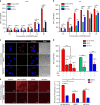Metastatic status of sentinel lymph nodes in breast cancer determined with photoacoustic microscopy via dual-targeting nanoparticles
- PMID: 33014359
- PMCID: PMC7494891
- DOI: 10.1038/s41377-020-00399-0
Metastatic status of sentinel lymph nodes in breast cancer determined with photoacoustic microscopy via dual-targeting nanoparticles
Abstract
Detection of sentinel lymph nodes (SLNs) is critical to guide the treatment of breast cancer. However, distinguishing metastatic SLNs from normal and inflamed lymph nodes (LNs) during surgical resection remains a challenge. Here, we report a CD44 and scavenger receptor class B1 dual-targeting hyaluronic acid nanoparticle (5K-HA-HPPS) loaded with the near-infra-red fluorescent dye DiR-BOA for SLN imaging in breast cancer. The small sized (~40 nm) self-assembled 5K-HA-HPPSs accumulated rapidly in the SLNs after intradermal injection. Compared with normal popliteal LNs (N-LN), there were ~3.2-fold and ~2.4-fold increases in fluorescence intensity in tumour metastatic SLNs (T-MLN) and inflamed LNs (Inf-LN), respectively, 6 h after nanoparticle inoculation. More importantly, photoacoustic microscopy (PAM) of 5K-HA-HPPS showed a significantly distinct distribution in T-MLN compared with N-LN and Inf-LN. Signals were mainly distributed at the centre of T-MLN but at the periphery of N-LN and Inf-LN. The ratio of PA intensity (R) at the centre of the LNs compared with that at the periphery was 5.93 ± 0.75 for T-MLNs of the 5K-HA-HPPS group, which was much higher than that for the Inf-LNs (R = 0.2 ± 0.07) and N-LNs (R = 0.45 ± 0.09). These results suggest that 5K-HA-HPPS injection combined with PAM provides a powerful tool for distinguishing metastatic SLNs from pLNs and inflamed LNs, thus guiding the removal of SLNs during breast cancer surgery.
Keywords: Optical materials and structures; Optical techniques.
© The Author(s) 2020.
Conflict of interest statement
Conflict of interestThe authors declare that they have no conflict of interest.
Figures








Similar articles
-
Effective treatment of metastatic sentinel lymph nodes by dual-targeting melittin nanoparticles.J Nanobiotechnology. 2023 Aug 1;21(1):245. doi: 10.1186/s12951-023-02026-7. J Nanobiotechnology. 2023. PMID: 37528426 Free PMC article.
-
Mapping Sentinel Lymph Node Metastasis by Dual-probe Optical Imaging.Theranostics. 2017 Jan 1;7(1):153-163. doi: 10.7150/thno.17085. eCollection 2017. Theranostics. 2017. PMID: 28042324 Free PMC article.
-
Dual-Modality Noninvasive Mapping of Sentinel Lymph Node by Photoacoustic and Near-Infrared Fluorescent Imaging Using Dye-Loaded Mesoporous Silica Nanoparticles.Mol Pharm. 2015 Sep 8;12(9):3119-28. doi: 10.1021/mp500698b. Epub 2015 Jul 27. Mol Pharm. 2015. PMID: 26132789
-
Maspin mRNA expression in sentinel lymph nodes predicts non-SLN metastasis in breast cancer patients with SLN metastasis.Histopathology. 2018 Dec;73(6):916-922. doi: 10.1111/his.13718. Epub 2018 Sep 25. Histopathology. 2018. PMID: 30035819
-
Molecular patterns of cancer colonisation in lymph nodes of breast cancer patients.Breast Cancer Res. 2018 Nov 20;20(1):143. doi: 10.1186/s13058-018-1070-3. Breast Cancer Res. 2018. PMID: 30458865 Free PMC article. Review.
Cited by
-
50-nm Gas-Filled Protein Nanostructures to Enable the Access of Lymphatic Cells by Ultrasound Technologies.Adv Mater. 2024 Jul;36(28):e2307123. doi: 10.1002/adma.202307123. Epub 2024 Apr 4. Adv Mater. 2024. PMID: 38533973 Free PMC article.
-
Advances in photoacoustic imaging aided by nano contrast agents: special focus on role of lymphatic system imaging for cancer theranostics.J Nanobiotechnology. 2023 Nov 20;21(1):437. doi: 10.1186/s12951-023-02192-8. J Nanobiotechnology. 2023. PMID: 37986071 Free PMC article. Review.
-
Nanovaccine-based strategies for lymph node targeted delivery and imaging in tumor immunotherapy.J Nanobiotechnology. 2023 Jul 23;21(1):236. doi: 10.1186/s12951-023-01989-x. J Nanobiotechnology. 2023. PMID: 37482608 Free PMC article. Review.
-
Near-infrared-II ratiometric fluorescence probes for non-invasive detection and precise navigation surgery of metastatic sentinel lymph nodes.Theranostics. 2022 Oct 9;12(16):7191-7202. doi: 10.7150/thno.78085. eCollection 2022. Theranostics. 2022. PMID: 36276643 Free PMC article.
-
Looking deep inside tissue with photoacoustic molecular probes: a review.J Biomed Opt. 2022 Jul;27(7):070901. doi: 10.1117/1.JBO.27.7.070901. Epub 2022 Jul 22. J Biomed Opt. 2022. PMID: 36451698 Free PMC article. Review.
References
-
- Siegel RL, Miller KD, Jemal A. Cancer statistics, 2019. CA: Cancer J. Clin. 2019;69:7–34. - PubMed
-
- Bray F, et al. Global cancer statistics 2018: GLOBOCAN estimates of incidence and mortality worldwide for 36 cancers in 185 countries. CA: A Cancer J. Clin. 2018;68:394–424. - PubMed
-
- Hayes DF. HER2 and breast cancer—a phenomenal success story. N. Engl. J. Med. 2019;381:1284–1286. - PubMed
LinkOut - more resources
Full Text Sources
Other Literature Sources
Miscellaneous

